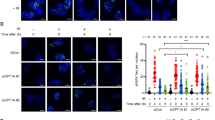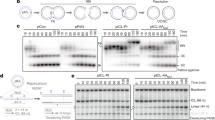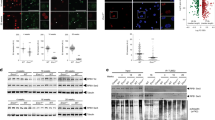Abstract
Oxidative stress converts lipids into DNA-damaging agents. The genomic lesions formed include 1,N6-ethenoadenine (εA) and 3,N4-ethenocytosine (εC), in which two carbons of the lipid alkyl chain form an exocyclic adduct with a DNA base. Here we show that the newly characterized enzyme AlkB repairs εA and εC. The potent toxicity and mutagenicity of εA in Escherichia coli lacking AlkB was reversed in AlkB+ cells; AlkB also mitigated the effects of εC. In vitro, AlkB cleaved the lipid-derived alkyl chain from DNA, causing εA and εC to revert to adenine and cytosine, respectively. Biochemically, εA is epoxidized at the etheno bond. The epoxide is putatively hydrolyzed to a glycol, and the glycol moiety is released as glyoxal. These reactions show a previously unrecognized chemical versatility of AlkB. In mammals, the corresponding AlkB homologs may defend against aging, cancer and oxidative stress.
This is a preview of subscription content, access via your institution
Access options
Subscribe to this journal
Receive 12 print issues and online access
$189.00 per year
only $15.75 per issue
Buy this article
- Purchase on Springer Link
- Instant access to full article PDF
Prices may be subject to local taxes which are calculated during checkout






Similar content being viewed by others
References
Aravind, L. & Koonin, E.V. The DNA-repair protein AlkB, EGL-9, and leprecan define new families of 2-oxoglutarate- and iron-dependent dioxygenases. Genome Biol. 2, Research 0007 (2001).
Trewick, S.C., Henshaw, T.F., Hausinger, R.P., Lindahl, T. & Sedgwick, B. Oxidative demethylation by Escherichia coli AlkB directly reverts DNA base damage. Nature 419, 174–178 (2002).
Falnes, P.O., Johansen, R.F. & Seeberg, E. AlkB-mediated oxidative demethylation reverses DNA damage in Escherichia coli. Nature 419, 178–182 (2002).
Duncan, T. et al. Reversal of DNA alkylation damage by two human dioxygenases. Proc. Natl. Acad. Sci. USA 99, 16660–16665 (2002).
Koivisto, P., Duncan, T., Lindahl, T. & Sedgwick, B. Minimal methylated substrate and extended substrate range of Escherichia coli AlkB protein, a 1-methyladenine-DNA dioxygenase. J. Biol. Chem. 278, 44348–44354 (2003).
Koivisto, P., Robins, P., Lindahl, T. & Sedgwick, B. Demethylation of 3-methylthymine in DNA by bacterial and human DNA dioxygenases. J. Biol. Chem. 279, 40470–40474 (2004).
Delaney, J.C. & Essigmann, J.M. Mutagenesis, genotoxicity, and repair of 1-methyladenine, 3-alkylcytosines, 1-methylguanine, and 3-methylthymine in alkB Escherichia coli. Proc. Natl. Acad. Sci. USA 101, 14051–14056 (2004).
Falnes, P.O. Repair of 3-methylthymine and 1-methylguanine lesions by bacterial and human AlkB proteins. Nucleic Acids Res. 32, 6260–6267 (2004).
Aas, P.A. et al. Human and bacterial oxidative demethylases repair alkylation damage in both RNA and DNA. Nature 421, 859–863 (2003).
Ougland, R. et al. AlkB restores the biological function of mRNA and tRNA inactivated by chemical methylation. Mol. Cell 16, 107–116 (2004).
Sedgwick, B. Repairing DNA-methylation damage. Nat. Rev. Mol. Cell Biol. 5, 148–157 (2004).
Ames, B.N., Shigenaga, M.K. & Hagen, T.M. Oxidants, antioxidants, and the degenerative diseases of aging. Proc. Natl. Acad. Sci. USA 90, 7915–7922 (1993).
Bjelland, S. & Seeberg, E. Mutagenicity, toxicity and repair of DNA base damage induced by oxidation. Mutat. Res. 531, 37–80 (2003).
Klaunig, J.E. & Kamendulis, L.M. The role of oxidative stress in carcinogenesis. Annu. Rev. Pharmacol. Toxicol. 44, 239–267 (2004).
Dedon, P.C. & Tannenbaum, S.R. Reactive nitrogen species in the chemical biology of inflammation. Arch. Biochem. Biophys. 423, 12–22 (2004).
Evans, M.D., Dizdaroglu, M. & Cooke, M.S. Oxidative DNA damage and disease: induction, repair and significance. Mutat. Res. 567, 1–61 (2004).
El Ghissassi, F., Barbin, A., Nair, J. & Bartsch, H. Formation of 1,N6-ethenoadenine and 3,N4-ethenocytosine by lipid peroxidation products and nucleic acid bases. Chem. Res. Toxicol. 8, 278–283 (1995).
Chung, F.L., Chen, H.J. & Nath, R.G. Lipid peroxidation as a potential endogenous source for the formation of exocyclic DNA adducts. Carcinogenesis 17, 2105–2111 (1996).
Marnett, L.J. Oxyradicals and DNA damage. Carcinogenesis 21, 361–370 (2000).
Blair, I.A. Lipid hydroperoxide-mediated DNA damage. Exp. Gerontol. 36, 1473–1481 (2001).
Lee, S.H., Arora, J.A., Oe, T. & Blair, I.A. 4-Hydroperoxy-2-nonenal-induced formation of 1,N2-etheno-2′-deoxyguanosine adducts. Chem. Res. Toxicol. 18, 780–786 (2005).
Nair, J., Barbin, A., Guichard, Y. & Bartsch, H. 1,N6-ethenodeoxyadenosine and 3,N4-ethenodeoxycytosine in liver DNA from humans and untreated rodents detected by immunoaffinity/32P-postlabeling. Carcinogenesis 16, 613–617 (1995).
Barbin, A. et al. Endogenous deoxyribonucleic acid (DNA) damage in human tissues: a comparison of ethenobases with aldehydic DNA lesions. Cancer Epidemiol. Biomarkers Prev. 12, 1241–1247 (2003).
Barbin, A. Etheno-adduct-forming chemicals: from mutagenicity testing to tumor mutation spectra. Mutat. Res. 462, 55–69 (2000).
Saparbaev, M., Kleibl, K. & Laval, J. Escherichia coli, Saccharomyces cerevisiae, rat and human 3-methyladenine DNA glycosylases repair 1,N6-ethenoadenine when present in DNA. Nucleic Acids Res. 23, 3750–3755 (1995).
Saparbaev, M. & Laval, J. 3,N4-ethenocytosine, a highly mutagenic adduct, is a primary substrate for Escherichia coli double-stranded uracil-DNA glycosylase and human mismatch-specific thymine-DNA glycosylase. Proc. Natl. Acad. Sci. USA 95, 8508–8513 (1998).
Engelward, B.P. et al. Base excision repair deficient mice lacking the Aag alkyladenine DNA glycosylase. Proc. Natl. Acad. Sci. USA 94, 13087–13092 (1997).
Ham, A.J. et al. New immunoaffinity-LC-MS/MS methodology reveals that Aag null mice are deficient in their ability to clear 1,N6-etheno-deoxyadenosine DNA lesions from lung and liver in vivo. DNA Repair (Amst.) 3, 257–265 (2004).
Pandya, G.A., Yang, I.Y., Grollman, A.P. & Moriya, M. Escherichia coli responses to a single DNA adduct. J. Bacteriol. 182, 6598–6604 (2000).
Mroczkowska, M.M., Kolasa, I.K. & Kusmierek, J.T. Chloroacetaldehyde-induced mutagenesis in Escherichia coli: specificity of mutations and modulation by induction of the adaptive response to alkylating agents. Mutagenesis 8, 341–348 (1993).
Borys, E., Mroczkowska-Slupska, M.M. & Kusmierek, J.T. The induction of adaptive response to alkylating agents in Escherichia coli reduces the frequency of specific C → T mutations in chloroacetaldehyde-treated M13 glyU phage. Mutagenesis 9, 407–410 (1994).
Basu, A.K., Wood, M.L., Niedernhofer, L.J., Ramos, L.A. & Essigmann, J.M. Mutagenic and genotoxic effects of three vinyl chloride-induced DNA lesions: 1,N6-ethenoadenine, 3,N4-ethenocytosine, and 4-amino-5-(imidazol-2-yl)imidazole. Biochemistry 32, 12793–12801 (1993).
Pandya, G.A. & Moriya, M. 1,N6-ethenodeoxyadenosine, a DNA adduct highly mutagenic in mammalian cells. Biochemistry 35, 11487–11492 (1996).
Levine, R.L. et al. Mutagenesis induced by a single 1,N6-ethenodeoxyadenosine adduct in human cells. Cancer Res. 60, 4098–4104 (2000).
Moriya, M., Zhang, W., Johnson, F. & Grollman, A.P. Mutagenic potency of exocyclic DNA adducts: marked differences between Escherichia coli and simian kidney cells. Proc. Natl. Acad. Sci. USA 91, 11899–11903 (1994).
Palejwala, V.A., Simha, D. & Humayun, M.Z. Mechanisms of mutagenesis by exocyclic DNA adducts. Transfection of M13 viral DNA bearing a site-specific adduct shows that ethenocytosine is a highly efficient RecA-independent mutagenic noninstructional lesion. Biochemistry 30, 8736–8743 (1991).
Singer, B. & Bartsch, H. (eds.). Exocyclic DNA Adducts in Mutagenesis and Carcinogenesis (International Agency for Research on Cancer, Lyon, France, 1999).
Thornburg, L.D., Lai, M.T., Wishnok, J.S. & Stubbe, J. A non-heme iron protein with heme tendencies: an investigation of the substrate specificity of thymine hydroxylase. Biochemistry 32, 14023–14033 (1993).
Nair, J. et al. Lipid peroxidation-induced etheno-DNA adducts in the liver of patients with the genetic metal storage disorders Wilson's disease and primary hemochromatosis. Cancer Epidemiol. Biomarkers Prev. 7, 435–440 (1998).
Bartsch, H. & Nair, J. Oxidative stress and lipid peroxidation-derived DNA-lesions in inflammation driven carcinogenesis. Cancer Detect. Prev. 28, 385–391 (2004).
Acknowledgements
We thank T.J. Begley for initially constructing the AlkB expression vector and A.M. Herrera and A. Fichera for NMR assistance. We further acknowledge the pioneering work of the late E. Seeberg and B. Singer. We thank Agilent Technologies for access to the 1100 MSD TOF mass spectrometer and J. Marr and J. Lau of Agilent for helpful discussions. This work was supported by the US National Institutes of Health (grants CA80024, CA75576; CA55043; ES11399; P01-CA26731; GM069857 and P30-ES02109).
Author information
Authors and Affiliations
Corresponding author
Ethics declarations
Competing interests
The authors declare no competing financial interests.
Supplementary information
Supplementary Fig. 1
Schematic for lesion bypass and mutagenesis studies in vivo. (PDF 30 kb)
Supplementary Fig. 2
Schematic for quantifying fully ligated genomes for the CRAB lesion bypass assay. (PDF 22 kb)
Supplementary Fig. 3
MALDI-TOF of εA vs. εC repair by AlkB (PDF 46 kb)
Supplementary Fig. 4
ESI-TOF of εA repair by AlkB (PDF 30 kb)
Rights and permissions
About this article
Cite this article
Delaney, J., Smeester, L., Wong, C. et al. AlkB reverses etheno DNA lesions caused by lipid oxidation in vitro and in vivo. Nat Struct Mol Biol 12, 855–860 (2005). https://doi.org/10.1038/nsmb996
Received:
Accepted:
Published:
Issue Date:
DOI: https://doi.org/10.1038/nsmb996
This article is cited by
-
Etheno adducts: from tRNA modifications to DNA adducts and back to miscoding ribonucleotides
Genes and Environment (2021)
-
Iron-catalysed oxidation intermediates captured in a DNA repair dioxygenase
Nature (2010)
-
AlkB recognition of a bulky DNA base adduct stabilized by chemical cross-linking
Science China Chemistry (2010)
-
Crystal structures of DNA/RNA repair enzymes AlkB and ABH2 bound to dsDNA
Nature (2008)
-
Structural basis for enzymatic excision of N1-methyladenine and N3-methylcytosine from DNA
The EMBO Journal (2007)



